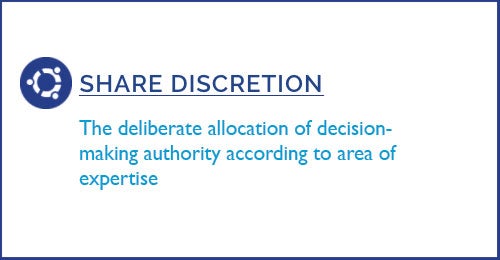Mar 14 2017 Diving Into The Intersector Toolkit: Share Discretion
 We recently updated our Toolkit for Intersector Collaboration to provide even more useful advice to practitioners involved in cross-sector collaborations. Each week we’ll be profiling one of our 17 tools, with a focus on resources that can help collaborations succeed.
We recently updated our Toolkit for Intersector Collaboration to provide even more useful advice to practitioners involved in cross-sector collaborations. Each week we’ll be profiling one of our 17 tools, with a focus on resources that can help collaborations succeed.
Cross-sector collaborations operate along a spectrum of partner interactions, from consultative relationships to those characterized by shared authority and joint decision making. Sharing discretion, the deliberate allocation of decision-making authority among partners according to their expertise, is not only the ninth tool in our Toolkit; it is at the center of our conception of cross-sector collaboration — true sharing of decision-making authority among partners. Sharing discretion based on expertise allows the collaboration to benefit from the diverse assets of each partner and gives each partner a distinct stake in the collaboration. The most effective collaborations work to develop collective understanding of partners’ strengths and contributions, increasing the likelihood that partners will be willing to share decision-making authority with others.
There are many ways of sharing decision-making authority in complex, multi-stakeholder environments. Spark Policy Institute’s Tools for Complex Decision-Making provides guidance, broken down into five steps, on how to construct a decision-making structure that best fits a collaboration’s context and needs. This resource provides options that collaboration partners may consider for decision-making — ranging from absolute consensus to majority rule to gradients of agreement — and provides troubleshooting advice for gridlock situations. This tool emphasizes that “a decision-making process is more likely to be successful if it is carefully designed upfront to ensure the process matches the context and needs.”
A Short Guide to Consensus Building, from The Consensus Building Handbook: A Comprehensive Guide to Reaching Agreement, offers another method of sharing decision-making authority in multi-stakeholder contexts. This resource presents itself as an alternative to Robert’s Rules of Order/ parliamentary procedure because of its emphasis on cooperation and consensus. It offers helpful instructions for its five steps in the consensus building process: convening, clarifying responsibilities, deliberating, deciding, and implementing agreements (permanent groups have a sixth step — organizational learning). It also offers guidance on addressing barriers to consensus building, such as responding to disruptive behavior, clarifying confidentiality agreements, and more
See Share Discretion in our Toolkit for further discussion on this topic, questions to guide tool use, and more.
Explore the full Toolkit and each of the 17 tools with enhanced discussion, questions to guide tool use, and additional resources here.
